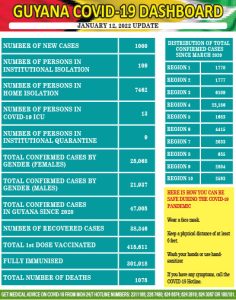…2 more deaths recorded
The rapid surge in COVID-19 cases continues in Guyana with a whopping 1,000 new infections detected within a 24-hour period, taking active cases in the country to over 7,000.
According to the Health Ministry in its updated COVID-19 Dashboard for Wednesday, the total number of confirmed cases in Guyana has gone up to 47,005. 
Of this, however, a staggering 7,584 are currently active cases. These include 13 patients in the COVID-19 Intensive Care Unit (ICU) and the remaining 7,571 persons are in isolation, that is, 109 in institutional isolation and the remaining 7,462 in home isolation.
Another nine persons are also in institutional quarantine, according to the Dashboard.
Meanwhile, the deaths of two more persons who tested positive for the novel coronavirus were reported.
These latest fatalities are a 57-year-old female from Region Five (Mahaica-Berbice) who was unvaccinated and died on Monday, and an 80-year-old female from Region Six (East Berbice-Corentyne), who was fully vaccinated and died on Tuesday.
With these, the total number of deaths from the pandemic in Guyana has gone up to 1,075, while the COVID-19 death toll for the year thus far is 20.
On the other hand, some 38,346 persons have recovered from the life-threatening disease to date – 54 more recoveries than the figure reported the previous day.
Since the outbreak of COVID-19 in the country, approximately 456,353 persons have been tested so far and of this, some 21,937 males and 25,068 females were found to be positive.
Of the 1,000 new cases reported on Wednesday, 24 were from Region One (Barima-Waini), 33 cases from Region Two (Pomeroon-Supenaam), 123 from Region Three (Essequibo Islands-West Demerara), a whopping 668 cases from Region Four (Demerara-Mahaica), another 11 from the Mahaica-Berbice region, 82 cases from Region Six, 32 more from Region Seven (Cuyuni-Mazaruni), and the remaining 27 cases from Region 10 (Upper Demerara-Upper Berbice).
There were no new cases recorded in Regions Eight (Potaro-Siparuni) and Nine (Upper Takutu-Upper Essequibo) within that 24-hour period, according to Wednesday’s Dashboard.
Health authorities have attributed the rapid rise in COVID-19 cases over the past three weeks to the Omicron variant, which though not deadly is highly transmissible.
Challenges, flock testing sites
In fact, Health Minister Dr Frank Anthony during Wednesday’s COVID-19 update, admitted that authorities are facing challenges as persons continue to flock government testing sites amid the Omicron surge. But in the same breath, he contended that the processing of samples only takes a few hours and therefore, persons should get their results within a short period of time.
“I don’t know where they’re getting a timeframe of ten days, we’re able to process PCR in a much faster way and in fact with the equipment that we have, we can process PCR within a 2-4-hour period, so I’m not sure where they’re getting that timeframe from,” Dr Anthony said in response to reports that persons who have tested at government facilities are waiting as much as 10 days before they get back their results.
According to information received by this publication, when persons get tested at government facilities, they are informed to isolate themselves until the results are returned to them within three days. However, this is not always the case as some people end up waiting a much longer time.
Nevertheless, the Health Minister said authorities are facing a challenge with persons flocking testing sites.
“We’ve had a challenge since we’ve had the Omicron surge, as soon as somebody’s infected, well not even infected, if there’s somebody who is tested positive, let’s say in a work environment, then all the co-workers, whether they have been directly exposed or not, everybody immediately want to be tested.”
“And they show up at our sites, and when they do so, they are putting an undue burden on the testing system,” he explained.
In this regard, the Minister reminded that testing too early can prevent persons from knowing their true status.
Dr Anthony had previously recommended that persons wait at least five days after a potential exposure before getting tested. The only exception, he had noted, is if they start to experience symptoms.
“You have to wait, there’s a window period for you to wait and if you test before that window period, obviously it’s going to be negative…people need to understand that if they truly want to understand their status whether negative or positive, they must first of all quarantine for a couple of days, and then come to do the test,” Dr Anthony reiterated on Wednesday.
“So, if it’s a PCR test that you’re doing then, at least that waiting time should be about four days, if it is the antigen test that you’re using, then antigen works best when the person is symptomatic,” the Minister further explained.
Nevertheless, persons are also urged to get vaccinated, and for those who are qualified to get their booster shots, in order to add a layer of protection against the virus.
So far, 415,611 or 81 per cent of adults have received a first dose of a COVID vaccine while 301,918 or 58.9 per cent have received both doses of the COVID vaccine.
For children 12 to 17, some 31,333 or 43 per cent have received a first dose of the Pfizer vaccines while 22,193 or 30.4 per cent have received both doses.
For booster doses, some 20,713 persons have received their jabs.
But as more people continue to get vaccinated, authorities are urging the public to continue observing all COVID-19 preventative measures, particularly masking in public, social distancing and frequent hand washing and sanitizing – which are more significant now with the rapidly-spreading Omicron variant. (G8)
